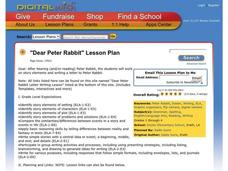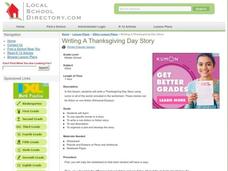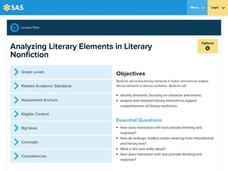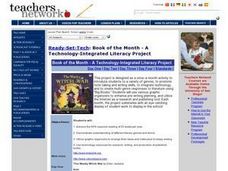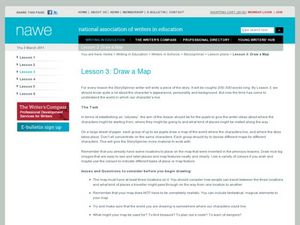Curated OER
Write, Right
This resource provides the beginning ideas for a instructional activity on writing a narrative. Learners watch a video, identify story elements, including plot and setting, and then write their own stories. If augmented, this...
Ideas From Suzi
Responding to Literature
Guide your class through a text with resources for before and after reading. Learners ask questions, discuss characters and plot points, point out elements of the reading that stood out, and compose brief summaries.
Curated OER
Picturing a Story
Students view slides from the movie "Hoot" and discuss characters, setting and the caption. They identify where in the rise and fall of the plot this scene takes place. They brainstorm elements needed to create a story from a picture....
Curated OER
Show Me the Story
Students examine the elements of a story, read a review of Chris Rock's new sitcom, "Everybody Hates Chris" and create original sitcom episodes based on their own lives.
Curated OER
Characterization
In this story elements worksheet, students complete a graphic organizer about characterization. Students describe the character's words, personality, appearance and reputation. There are four bubbles within the graphic organizer to...
Curated OER
Understanding Protagonists and Antagonists
How can you tell if a character is a villain? What about a hero? Work on literary analysis with an engaging language arts worksheet. After completing an activity about the four types of conflict, learners fill out a character map about a...
Curated OER
Introduce: Comparison and Contrast
Class discussions can really make concepts come to life. The class discusses the differences between compare and contrast, read a book, then talk about ways they can compare events or characters in the story. Good leading question are...
Curated OER
The "Write" Stuff: Strategies and Conventions for Imaginative Writing
Fifth graders develop and practice the steps involved in imaginative writing. They follow the steps/worksheets included and write imaginative stories of their own.
Curated OER
Tone and Mood
How are mood and tone similar? Different? Help your readers understand the difference between the two with this helpful guide. On the first page, they read the definition for both tone and mood and identify words that are describe each....
Gobal Oneness Project
Passionate Pursuits
Not all technology is digital. Teach learners about the low-tech maker movement with a photo essay about six artisans from California and two articles about the local creator movement. After tackling the photo essay in small groups,...
Curated OER
Dear Peter Rabbit
Write dear old Peter Rabbit a letter with this lesson. First, youngsters listen to the story Peter Rabbit and analyze the story elements. Then they complete a story map graphic organizer in order to write a letter to Peter Rabbit using...
Curated OER
Comparing Characters Across Two Short Stories
Ninth graders listen to a read aloud of two short stories focusing on literary devices. The write about the settings and realism of the stories, and decide each main character handles the conflict he faces with nature.
Curated OER
Writing A Thanksgiving Day Story
Students write a Thanksgiving Day Story using some or all of the words included in the worksheet. These stories can be fiction or non-fiction (Personal Essays). They are graded on sentence structure, paragraph structure, grammar,...
Curated OER
Completing a Christmas Story
Students discuss with teacher how to complete a short story and the elements necessary: characters, settings, themes, and plots. They then use the worksheet to complete the short story.
Pennsylvania Department of Education
Analyzing Literary Elements in Literary Nonfiction
Fourth graders identify the literary elements of a nonfiction text. In this literary elements lesson, 4th graders read the text Piano Starts Here--The Young Art Tatum and fill in a chart that includes the events from the book....
Curated OER
A Little Mystery and Intrigue in Writing Short Detective Stories
Students read and analyze the twelve short stories in the novel "The Adventures of Sherlock Holmes." They create their own detective that has to solve a new kind of crime, and write and edit a short story with their original detective as...
Curated OER
Book of the Month - A Technology-Integrated Literacy Project
Students write a paragraph predicting what the book is about after viewing the front cover. They are given a copy of the Story Parts Maps, students are explained each story part. Students are explained that they most take notes on the...
Curated OER
The Magic Key
Students are able to recall details in a story such as characters, plot, and setting. They are able to create a verbal story about a toy of his/her choice. Students are able to work cooperatively with a partner to create a story.
Curated OER
Draw a Map
Students draw a map. In this map drawing lesson students draw a map to show where a character is from and where they are going in the story. Students are writing an odyssey.
Curated OER
Number the Stars, Lesson 3
Students consider how an author creates a feeling of suspense in a reader's mind. They analyze characters in the story. Students make a character map for Peter. They discuss how suspense unfolds in the novel Number the Stars.
Curated OER
Retell the "Tail" of the Tale
Students explore story structure. In this multicultural literacy lesson, students discuss common elements of folk tales and then listen to the story Tiger and the Big Wind: A Tale from Africa. Students identify the problem and solution...
Pennsylvania Department of Education
Exploring Key Ideas and Details in Fiction and Nonfiction
Third graders participate in activities to differentiate fiction from nonfiction. In this fiction lesson, 3rd graders describe the elements of a fiction story. Students compare and contrast fiction and non fiction elements. Students...
Curated OER
Literature Analysis
Students explore the concept of literature analysis. In this literature analysis lesson, students discuss the story elements of a book. Students also discover how to pair share and use each other as a resource.
Curated OER
Interpreting Dramatic Works
Action! Delve into character development in the play Fences by August Wilson, setting the stage for learners to analyze character nuances. Thespians choose a scene from the script, responding with a written account of the character's...












